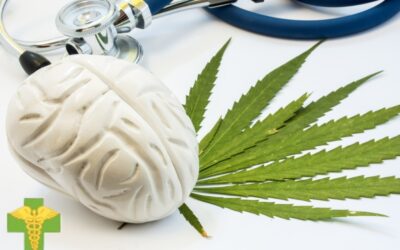Can Medical Marijuana (MMJ) Help Patients with Persistent Muscle Spasms
We’ve all felt a Charlie horse, a stitch in our side, or a leg cramp once in a while. These are examples of simple muscle spasms, and they’re usually nothing to worry about. However, for patients with persistent muscle spasms, these conditions take on a more serious tone. In this post, our Colorado Springs, CO doctors will address the question: can medical marijuana help relieve persistent muscle spasms?
What are Persistent Muscle Spasms?
“Persistent muscle spasms” isn’t the name of one single condition or disease. Instead, the state of Colorado uses the term persistent muscle spasms as a catch-all to include a variety of tics, tremors, and uncontrollable movements as qualifying conditions for medical marijuana.
Several specific types of spastic conditions fall under the “persistent muscle spasms” umbrella. The state of Colorado classifies these as “debilitating” conditions, the most severe types of disorders that medical marijuana may be able to treat.
Dystonia
Dystonia is a group of persistent muscle spasms that result from chemical imbalances within the nervous system. Dystonia can be localized to a single place in the body, like the jaw, neck, vocal cords, hands, arms, and legs. Or, they can or occur across the entire body at the same time. Symptoms of dystonia include:
- Pain
- Difficulty performing tasks
- Mobility problems
- Repetitive twisting motions
Certain tasks, like writing or running, may cause dystonia symptoms to worsen. Dystonia is a chronic condition, meaning that patients will need to live with it for their entire lives. There’s no cure for the condition, and it will get progressively worse as patients age. Onset usually occurs sometime after 21 years of age.
One specific type of dystonia, called blepharospasms, involves types of involuntary persistent muscle spasms occur in the eye. They usually present themselves as uncontrollable eye twitches, repeated unconscious blinking, and light sensitivity. Blepharospasms arise when a specific region of the brain – which controls eye movement – malfunctions. They can cause everyday activities, like reading, driving, or even walking, difficult.
While blepharospasms may come and go normally, they can sometimes develop into a chronic condition. Currently, the FDA allows patients to choose between two treatments for these spasms: injections and surgery. Surgery involves removing part of the twitching muscle, while injections include botulism toxin (the same thing used for BOTOX injections).
Multiple Sclerosis (MS)
Multiple sclerosis (or simply “MS”) is a debilitating and rare type of central nervous system condition. In MS, the body’s own immune system attacks the patient’s nerve cell sheath, called myelin. This damage to the myelin will eventually disrupt the communication between a patient’s brain and the rest of their bodies.
MS onset can happen at any time, usually between the ages of 20 and 40. Symptoms of the condition include:
- Weakness and numbness
- Loss of muscle coordination
- Tremors and spasms
- Difficulty walking or moving
- Loss of vision
- Slurring speech
There is no cure for MS. The disease may undergo remittance, where a patient’s symptoms become less severe for a span of months or years. However, MS will always return, and its symptoms will get progressively worse over time. The condition is more prevalent among women than men, with approximately 2 female cases for each male one.
Can Medical Marijuana Help Persistent Muscle Spasms?
There are a variety of types of persistent muscle spasm disorders, all of which have different root causes. However, medical marijuana seems to be somewhat effective at alleviating many different types of persistent spastic disorders.
Dystonia
Using medical marijuana to treat dystonia isn’t a new idea. In fact, humans have used medical marijuana to treat dystonia arising from tetanus for hundreds of years.
Recent data suggests that medical marijuana may be an effective treatment for blepharospasms. In the study, patients reported how medical marijuana their blepharospasm symptoms between September 2015 and May 2016. These patients were already using traditional botulism injection treatments and studied the effectiveness once medical cannabis was added to their treatment regimen.
The study had promising results. About 75 percent of participants reported that medical marijuana eased their symptoms by reducing spasm duration and frequency. Researchers did note that this study was preliminary, and that more research would be necessary to verify its results.
Multiple Sclerosis (MS)
Medical marijuana may be an option for MS patients seeking relief from their symptoms. Not only that, but it may actually help slow the progression of the condition itself.
Data indicates that the endocannabinoid system (ECS) may play a part in the degeneration of nerve sheathes that causes MS. Anandamide, an endocannabinoid that the body creates itself, appears to have neuroprotective effects on the nerve cell sheath. Researchers have shown that THC can mimic some of the effects of anandamide, reducing the severity and frequency of tremors in MS patients. Interestingly, CBD doesn’t seem to have this same effect – only THC.
Researchers did note that the data was preliminary, and further research regarding medical marijuana’s effects on MS is needed. But they’re hopeful, and many believe that medical marijuana may lead to new breakthrough MS treatments.
Can I use Medical Marijuana for Persistent Muscle Spasms?
If you suffer from persistent muscle spasms and need relief, medical marijuana may be able to help. The state of Colorado has approved medical marijuana as a qualifying medical condition to receive a cannabis prescription.
We’ll review your symptoms and work with you to create a treatment plan. Then, you can apply for one of the state’s medical marijuana red cards. To learn more, contact us online or by phone at (719) 246-0393 to schedule an appointment.
Works Cited:
1. https://cdphe.colorado.gov/apply-colorado-medical-marijuana-card
2. https://www.nei.nih.gov/learn-about-eye-health/eye-conditions-and-diseases/blepharospasm
3. https://www.mayoclinic.org/diseases-conditions/multiple-sclerosis/symptoms-causes/syc-20350269
4. https://thcmuseum.org/the-history/
5. https://www.ncbi.nlm.nih.gov/pmc/articles/PMC5764009/
6. https://www.ncbi.nlm.nih.gov/pmc/articles/PMC2626929/
7. https://medicalalternativesclinics.com







